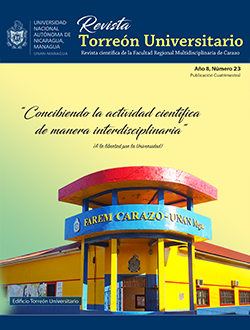Natural contamination by arsenic in the groundwater of the rural community "La Fuente", to suggest and promote the use of alternative sources of safe water, municipality La Paz Centro, León, Nicaragua
DOI:
https://doi.org/10.5377/torreon.v8i23.9533Keywords:
contamination, hydrothermal alteration, arsenic, geogenic sourcesAbstract
Previous studies have revealed that in Nicaragua the presence of arsenic is of geogenic origin, so it is common to find it in both, surface, and underground waters, soil, rocks and sediments; besides being found within volcanic complexes, fumaroles, hot springs, gases and geothermal fluids. It was until 2010, when arsenic was detected in volcanic and sedimentary materials of the Quaternary present in the volcanic arc front of Los Maribios Mountain Range. Thus, in the La Fuente community located NE of the Momotombo-El Hoyo volcanic complex and near the Monte Galán volcanic caldera, where 112 families are supplied by groundwater, the total arsenic concentration in water from 30 dug wells, three drilled wells and a spring was determined. Arsenic concentrations ranged from 2 µg•l-1 to 103 µg•l-1, where 70% of the analyzed samples (24 water sources) exceed the national limit adopted, 10 µg As∙l-1 for water for human consumption. The places with the highest temperatures (35.6 to 45.8 ° C) are the ones with the highest concentrations of arsenic (38 to 103 µg•l-1), higher values of electrical conductivity (983 - 1140 µS∙cm-1) and lower pH values (5.80 - 7.08 units). Community members were informed about the risk to which they are exposed by ingesting contaminated water with high values of this toxic; at the same time, safe sources of water for human consumption were identified, which were recommended to users. This research, in addition to generating scientific information, becomes a tool to support decision-making for the authorities and for local people, by using alternative water sources for human consumption and for food preparation.
Downloads
Downloads
Published
How to Cite
Issue
Section
License
The authors who publish in this journal agree to the following terms.
- The author or authors of the articles, essays or research grant the National Autonomous University of Nicaragua, Managua (UNAN-Managua) the editing rights (copyright) of the submitted work, therefore the University has the exclusive right to publish the article for the entire copyright period.
- These copyrights/authors authorize Torreón Universitario Magazine and the University to edit and disseminate/publish the article in said Magazine, including printed and electronic reproduction, storage, retrieval and any other type of publication, and sources of secondary information as services. of summaries and databases, they also empower it to protect the article against unauthorized use for dissemination by printed or electronic media (PDF, HTML, EPUB, XML or others).
License for use of content
The magazine uses the Creative Commons Attribution-NonCommercial-NoDerivs 4.0 International License.
Under this statement:

This journal is licensed under a Creative Commons Attribution-NonCommercial-NoDerivatives 4.0 International License. It can be copied, distributed and transmitted publicly as long as the author and source are cited (Revista Torreón Universitario), it should not be modified or used for any commercial purpose. The full license can be found at http://creativecommons.org/licenses/by-nc-nd/4.0/.



